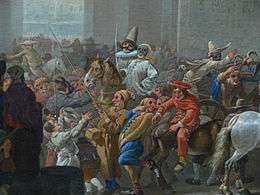Mardi Gras in New Orleans
The holiday of Mardi Gras is celebrated in all of Louisiana, including the city of New Orleans. Celebrations are concentrated for about two weeks before and through Shrove Tuesday, the day before Ash Wednesday (the start of lent in the Western Christian tradition). Usually there is one major parade each day (weather permitting); many days have several large parades. The largest and most elaborate parades take place the last five days of the Mardi Gras season. In the final week, many events occur throughout New Orleans and surrounding communities, including parades and balls (some of them masquerade balls).

The parades in New Orleans are organized by social clubs known as krewes; most follow the same parade schedule and route each year. The earliest-established krewes were the Mistick Krewe of Comus, the earliest, Rex, the Knights of Momus and the Krewe of Proteus. Several modern "super krewes" are well known for holding large parades and events, such as the Krewe of Endymion (which is best known for naming celebrities as grand marshals for their parades), the Krewe of Bacchus (similarly known for naming celebrities as their Kings), as well as the Zulu Social Aid & Pleasure Club—a predominantly African American krewe. Float riders traditionally toss throws into the crowds. The most common throws are strings of colorful plastic beads, doubloons, decorated plastic "throw cups", Moon Pies, and small inexpensive toys, but throws can also include lingerie and more sordid items. Major krewes follow the same parade schedule and route each year.
While many tourists center their Carnival season activities on Bourbon Street and in New Orleans and Dauphin, major parades originate in the Uptown and Mid-City districts and follow a route along St. Charles Avenue and Canal Street, on the upriver side of the French Quarter. Mardi Gras day traditionally concludes with the "Meeting of the Courts" between Rex and Comus.[1]
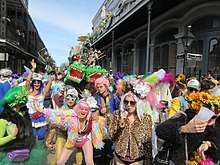
History
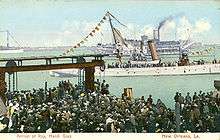
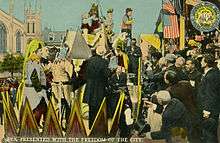

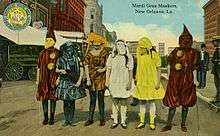

The first record of Mardi Gras being celebrated in Louisiana was at the mouth of the Mississippi River in what is now lower Plaquemines Parish, Louisiana, on March 2, 1699. Iberville, Bienville, and their men celebrated it as part of an observance of Catholic practice. The date of the first celebration of the festivities in New Orleans is unknown. A 1730 account by Marc-Antione Caillot celebrating with music and dance, masking and costuming (including cross-dressing). Excerpt | A Company Man - The Book An account from 1743 that the custom of Carnival balls was already established. Processions and wearing of masks in the streets on Mardi Gras took place. They were sometimes prohibited by law, and were quickly renewed whenever such restrictions were lifted or enforcement waned. In 1833 Bernard Xavier de Marigny de Mandeville, a rich plantation owner of French descent, raised money to fund an official Mardi Gras celebration.
James R. Creecy in his book Scenes in the South, and Other Miscellaneous Pieces describes New Orleans Mardi Gras in 1835:[2]
Shrove Tuesday is a day to be remembered by strangers in New Orleans, for that is the day for fun, frolic, and comic masquerading. All of the mischief of the city is alive and wide awake in active operation. Men and boys, women and girls, bond and free, white and black, yellow and brown, exert themselves to invent and appear in grotesque, quizzical, diabolic, horrible, strange masks, and disguises. Human bodies are seen with heads of beasts and birds, beasts and birds with human heads; demi-beasts, demi-fishes, snakes' heads and bodies with arms of apes; man-bats from the moon; mermaids; satyrs, beggars, monks, and robbers parade and march on foot, on horseback, in wagons, carts, coaches, cars, &c., in rich confusion, up and down the streets, wildly shouting, singing, laughing, drumming, fiddling, fifeing, and all throwing flour broadcast as they wend their reckless way.
In 1856 21 businessmen gathered at a club room in the French Quarter to organize a secret society to observe Mardi Gras with a formal parade. They founded New Orleans' first and oldest krewe, the Mystick Krewe of Comus. According to one historian, "Comus was aggressively English in its celebration of what New Orleans had always considered a French festival. It is hard to think of a clearer assertion than this parade that the lead in the holiday had passed from French-speakers to Anglo-Americans. ... To a certain extent, Americans 'Americanized' New Orleans and its Creoles. To a certain extent, New Orleans 'creolized' the Americans. Thus the wonder of Anglo-Americans boasting of how their business prowess helped them construct a more elaborate version than was traditional. The lead in organized Carnival passed from Creole to American just as political and economic power did over the course of the nineteenth century. The spectacle of Creole-American Carnival, with Americans using Carnival forms to compete with Creoles in the ballrooms and on the streets, represents the creation of a New Orleans culture neither entirely Creole nor entirely American."[3]
In 1875 Louisiana declared Mardi Gras a legal state holiday.[4] War, economic, political, and weather conditions sometimes led to cancellation of some or all major parades, especially during the American Civil War, World War I and World War II, but the city has always celebrated Carnival.[4]
In 1979 the New Orleans police department went on strike. The official parades were canceled or moved to surrounding communities, such as Jefferson Parish, Louisiana. Significantly fewer tourists than usual came to the city. Masking, costuming, and celebrations continued anyway, with National Guard troops maintaining order. Guardsmen prevented crimes against persons or property but made no attempt to enforce laws regulating morality or drug use; for these reasons, some in the French Quarter bohemian community recall 1979 as the city's best Mardi Gras ever.
In 1991 the New Orleans City Council passed an ordinance that required social organizations, including Mardi Gras Krewes, to certify publicly that they did not discriminate on the basis of race, religion, gender or sexual orientation, to obtain parade permits and other public licenses.[5] Shortly after the law was passed, the city demanded that these krewes provide them with membership lists, contrary to the long-standing traditions of secrecy and the distinctly private nature of these groups. In protest—and because the city claimed the parade gave it jurisdiction to demand otherwise-private membership lists—the 19th-century krewes Comus and Momus stopped parading.[6] Proteus did parade in the 1992 Carnival season but also suspended its parade for a time, returning to the parade schedule in 2000.
Several organizations brought suit against the city, challenging the law as unconstitutional. Two federal courts later declared that the ordinance was an unconstitutional infringement on First Amendment rights of free association, and an unwarranted intrusion on the privacy of the groups subject to the ordinance.[7] The US Supreme Court refused to hear the city's appeal from this decision.
Today, New Orleans krewes operate under a business structure; membership is open to anyone who pays dues, and any member can have a place on a parade float.
Effects of Hurricane Katrina
The devastation caused by Hurricane Katrina on August 29, 2005 caused a few people to question the future of the city's Mardi Gras celebrations. Mayor Nagin, who was up for reelection in early 2006, tried to play this sentiment for electoral advantage. However, the economics of Carnival were, and are, too important to the city's revival.
The city government, essentially bankrupt after Hurricane Katrina, pushed for a scaled back celebration to limit strains on city services. However, many krewes insisted that they wanted to and would be ready to parade, so negotiations between krewe leaders and city officials resulted in a compromise schedule. It was scaled back but less severely than originally suggested.
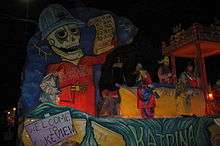
The 2006 New Orleans Carnival schedule included the Krewe du Vieux on its traditional route through Marigny and the French Quarter on February 11, the Saturday two weekends before Mardi Gras. There were several parades on Saturday, February 18, and Sunday the 19th a week before Mardi Gras. Parades followed daily from Thursday night through Mardi Gras. Other than Krewe du Vieux and two Westbank parades going through Algiers, all New Orleans parades were restricted to the Saint Charles Avenue Uptown to Canal Street route, a section of the city which escaped significant flooding. Some krewes unsuccessfully pushed to parade on their traditional Mid-City route, despite the severe flood damage suffered by that neighborhood.
The city restricted how long parades could be on the street and how late at night they could end. National Guard troops assisted with crowd control for the first time since 1979. Louisiana State troopers also assisted, as they have many times in the past. Many floats had been partially submerged in floodwaters for weeks. While some krewes repaired and removed all traces of these effects, others incorporated flood lines and other damage into the designs of the floats.
Most of the locals who worked on the floats and rode on them were significantly affected by the storm's aftermath. Many had lost most or all of their possessions, but enthusiasm for Carnival was even more intense as an affirmation of life. The themes of many costumes and floats had more barbed satire than usual, with commentary on the trials and tribulations of living in the devastated city. References included MREs, Katrina refrigerators and FEMA trailers, along with much mocking of the Federal Emergency Management Agency (FEMA) and local and national politicians.
By the 2009 season, the Endymion parade had returned to the Mid-City route, and other Krewes expanding their parades Uptown.
2020 tandem float incidents
In 2020, two parade attendees—one during the Nyx parade, and one during the Endymion parade, were killed after being struck and run over in between interconnected "tandem floats" towed by a single vehicle. Following the incident during the Nyx parade, there were calls for New Orleans officials to address safety issues with these floats (including outright bans, or requiring the gaps to be filled in using a barrier). Following the second death during the Endymion parade on February 22, 2020 (which caused the parade to be halted and cancelled), city officials announced that tandem floats would be banned effective immediately, with vehicles restricted to one, single float only.[8][9][10]
Coronavirus pandemic
Unknown to the participants and local leaders at the time, the 2020 Carnival season (with parades running from January through Mardi Gras Day on February 25) coincided with increasing spread of coronavirus disease 2019 (COVID-19) in the United States as part of a global pandemic.[11] At the time, the disease was actively being dismissed as a major public health threat by the Trump administration.[12] As such, federal officials did not advise against the holding of Mardi Gras festivities, and scrutiny over mass public gatherings and events that induce international tourism had yet to emerge.[11] The first case of COVID-19 in Louisiana was reported on March 9, two weeks after the end of Mardi Gras.[13]
Subsequently, the state of Louisiana saw a significant impact from the pandemic, with New Orleans in particular seeing a high rate of cases. Louisiana State University (LSU) associate professor Susanne Straif-Bourgeoi suggested that the rapid spread may have been aided by Mardi Gras festivities.[14][15][14] Researchers of the University of Louisiana at Lafayette estimated that Louisiana had the fastest growth rate of cases (67.8%, overtaking overtaking New York's 66.1% growth) in the 14 days since its first reported case than any region in the world.[16][14]
Mayor LaToya Cantrell stated that she would have cancelled Mardi Gras festivities had she been provided with sufficient warning by the federal government, and criticized the Trump administration for downplaying the threat.[11][17]
Traditional colors
.svg.png)
The colors traditionally associated with Mardi Gras in New Orleans are green, gold, and purple. The colors were first specified in proclamations by the Rex organization during the lead-up to their inaugural parade in 1872, suggesting that balconies be draped in banners of these colors. It is unknown why these specific colors were chosen; some accounts suggest that they were initially selected solely on their aesthetic appeal, as opposed to any true symbolism.[18][19]
Errol Laborde, author of Marched the Day God: A History of the Rex Organization, presented a theory that the colors were based on heraldry: all three colors correspond to a heraldic tincture, and Rex's goal may have been to create a tricolor to represent their "kingdom". Purple was widely associated with royalty, while white was already heavily used on other national flags, and was thus avoided. Furthermore, he noted that a flag in green, gold and purple in that order complies with the rule of tincture, which states that metals (gold or silver) can only be placed on or next to other colors, and that colors cannot be placed on or next to other colors.[18]
Following a color-themed Rex parade in 1892 that featured purple, green, and gold-colored floats themed around the concepts, the Rex organization retroactively declared that the three colors symbolized justice, power, and faith. The traditional colors are commonly addressed as purple, green, and gold, in that order—even though this order violates the rule of tincture.[18][20]
Contemporary Mardi Gras


Epiphany
Epiphany, on January 6, has been recognized as the start of the New Orleans Carnival season since at least 1900; locally, it is sometimes known as Twelfth Night although this term properly refers to Epiphany Eve, January 5, the evening of the twelfth day of Christmastide.[21] The Twelfth Night Revelers, New Orleans' second-oldest Krewe, have staged a parade and masked ball on this date since 1870.[22] A number of other groups such as the Phunny Phorty Phellows, La Société Pas Si Secrète Des Champs-Élysées and the Krewe de Jeanne D'Arc have more recently begun to stage events on Epiphany as well.[23]
Many of Carnival's oldest societies, such as the Independent Strikers' Society, hold masked balls but no longer parade in public.
Mardi Gras season continues through Shrove Tuesday or Fat Tuesday.
Days leading up to Mardi Gras Day
The population of New Orleans more than doubles during the five days before Mardi Gras Day, in anticipation of the biggest celebration.
Wednesday night begins with Druids, and is followed by the Mystic Krewe of Nyx, the newest all-female Krewe. Nyx is famous for their highly decorated purses, and has reached Super Krewe status since their founding in 2011.
Thursday night starts off with another all-women's parade featuring the Krewe of Muses. The parade is relatively new, but its membership has tripled since its start in 2001. It is popular for its throws (highly sought-after decorated shoes and other trinkets) and themes poking fun at politicians and celebrities. Thursdays are also marked by the great gumbo orgy on Toulouse Street in the French Quarter. This sausage-filled experience began in 1809 and has French-Acadian roots.
Friday night is the occasion of the large Krewe of Hermes and satirical Krewe D'État parades, ending with one of the fastest-growing krewes, the Krewe of Morpheus.[24] There are several smaller neighborhood parades like the Krewe of Barkus and the Krewe of OAK.
Several daytime parades roll on Saturday (including Krewe of Tucks and Krewe of Isis) and on Sunday (Thoth, Okeanos, and Krewe of Mid-City).
The first of the "super krewes," Endymion, parades on Saturday night, with the celebrity-led Bacchus parade on Sunday night 1998
Mardi Gras
The celebrations begin early on Mardi Gras, which can fall on any Tuesday between February 3 and March 9 (depending on the date of Easter, and thus of Ash Wednesday).[25]
In New Orleans, the Zulu parade rolls first, starting at 8 am on the corner of Jackson and Claiborne and ending at Broad and Orleans, Rex follows Zulu as it turns onto St. Charles following the traditional Uptown route from Napoleon to St. Charles and then to Canal St. Truck parades follow Rex and often have hundreds of floats blowing loud horns, with entire families riding and throwing much more than just the traditional beads and doubloons. Numerous smaller parades and walking clubs also parade around the city. The Jefferson City Buzzards, the Lyons Club, the Irish Channel Corner Club, Pete Fountain's Half Fast Walking Club and the KOE all start early in the day Uptown and make their way to the French Quarter with at least one jazz band. At the other end of the old city, the Society of Saint Anne journeys from the Bywater through Marigny and the French Quarter to meet Rex on Canal Street. The Pair-O-Dice Tumblers rambles from bar to bar in Marigny and the French Quarter from noon to dusk. Various groups of Mardi Gras Indians, divided into uptown and downtown tribes, parade in their finery.
For upcoming Mardi Gras Dates through 2050 see Mardi Gras Dates.
Costumes and masks
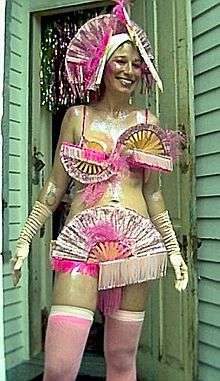
In New Orleans, costumes and masks are seldom publicly worn by non-Krewe members on the days before Fat Tuesday (other than at parties), but are frequently worn on Mardi Gras. Laws against concealing one's identity with a mask are suspended for the day. Banks are closed, and some businesses and other places with security concerns (such as convenience stores) post signs asking people to remove their masks before entering.
Throws
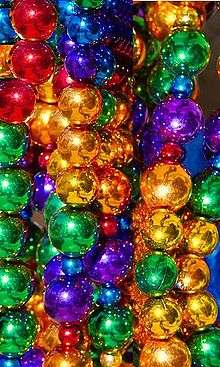
A 'throw' is the collective term used for the objects that are thrown from floats to parade-goers. Until the 1960s, the most common form was multi-colored strings of glass beads made in Czechoslovakia.
Glass beads were supplanted by less expensive and more durable plastic beads, first from Hong Kong, then from Taiwan, and more recently from China. Lower-cost beads and toys allow float-riders to purchase greater quantities, and throws have become more numerous and common.
In the 1990s, many people lost interest in small, cheap beads, often leaving them where they landed on the ground. Larger, more elaborate metallic beads and strands with figures of animals, people, or other objects have become the sought-after throws. David Redmond's 2005 film of cultural and economic globalization, Mardi Gras: Made in China, follows the production and distribution of beads from a small factory in Fuzhou, China to the streets of New Orleans during Carnival.[26] The publication of Redmon's book, Beads, Bodies, and Trash: Public Sex, Global Labor, and the Disposability of Mardi Gras, follows up on the documentary by providing an ethnographic analysis of the social harms, the pleasures, and the consequences of the toxicity that Mardi Gras beads produce.[27]
In addition to the toxicity of tons of plastic, eye injuries from Mardi Gras parade throws are commonplace, and more severe injuries—such as a fractured skull in an infant struck by a coconut—have also been known to occur.[28]
With the advent of the 21st century, more sophisticated throws began to replace simple metallic beads. Krewes started to produce limited edition beads and plush toys that are unique to the krewe. Nowadays yelling the phrase “throw me something mister!” means you could catch a huge assortment of items with fiber optic beads and LED-powered prizes, medallions, doubloons and soft toys among the most sought-after items. In a retro-inspired twist, glass beads have returned to parades. Now made in India, glass beads are one of the most valuable throws. However, the most commonly associated throws are still strings of plastic beads.[29]
Other Mardi Gras traditions
Social clubs

New Orleans Social clubs play a very large part in the Mardi Gras celebration as hosts of many of the parades on or around Mardi Gras. The two main Mardi Gras parades, Zulu and Rex, are both social club parades. Zulu is a mostly African-American club and Rex is mostly Caucasian. Social clubs host Mardi Gras balls, starting in late January. At these social balls, the queen of the parade (usually a young woman between the ages of 18 and 21, not married and in high school or college) and the king (an older male member of the club) present themselves and their court of maids (young women aged 16 to 21), and different divisions of younger children with small roles in the ball and parade, such as a theme-beformal neighborhood Carnival club ball at local bar room.
In response to their exclusion from Rex, in 1909 Créole and black New Orleanians, led by a mutual aid group known as "The Tramps", adorned William Storey with a tin can crown and banana stalk scepter and named him King Zulu.[5][30] This display was meant as a mockery of Rex's overstated pageantry, but in time, Zulu became a grand parade in its own right. By 1949, as an indication of Zulu's increase in prestige, the krewe named New Orleans' native son Louis Armstrong as its king.[4]
Being a member of the court requires much preparation, usually months ahead. Women and girls must have dress fittings as early as the May before the parade, as the season of social balls allows little time between each parade. These balls are generally by invitation only. Balls are held at a variety of venues in the city, large and small, depending on the size and budget of the organization. In the late 19th and early 20th century, the French Opera House was a leading venue for New Orleans balls. From the mid 20th century until Hurricane Katrina the Municipal Auditorim was the city's most famous site for Carnival balls. In more recent years, most are at the ballrooms of various hotels throughout the city. The largest "Super Krewes" use larger venues; Bacchus the Morial Convention Center and Endymion the Superdome.
Doubloons
One of the many Mardi Gras throws which krewes fling into the crowds, doubloons are large coins, either wood or metal, made in Mardi Gras colors. Artist H. Alvin Sharpe created the modern doubloon for The School of Design (the actual name of the Rex organization). According to the krewe history, in January 1959 Sharpe arrived at the offices of the captain of the krewe with a handful of aluminum discs. Upon entering the office, he threw the doubloons into the captain's face to prove that they would be safe to throw from the floats. Standard krewe doubloons usually portray the Krewe's emblem, name, and founding date on one side, and the theme and year of the parade and ball on the other side. Royalty and members of the court may throw specialty doubloons, such as the special Riding Lieutenant doubloons given out by men on horseback in the Rex parade. In the last decade, krewes have minted doubloons specific to each float. Krewes also mint special doubloons of cloisonné or pure silver for its members. They never throw these from the floats. Original Rex doubloons are valuable, but it is nearly impossible for aficionados to find a certified original doubloon. The School of Design did not begin dating their doubloons until a few years after their introduction.
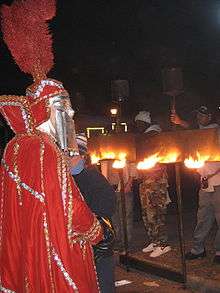
Flambeau carriers
The flambeau ("flahm-bo" meaning flame-torch) carrier originally, before electric lighting, served as a beacon for New Orleans parade goers to better enjoy the spectacle of night parades. The first flambeau carriers were slaves.
Today, the flambeaux are a connection to the New Orleans version of Carnival and a valued contribution. Many people view flambeau-carrying as a kind of performance art – a valid assessment given the wild gyrations and flourishes displayed by experienced flambeau carriers in a parade. Many individuals are descended from a long line of carriers.
Parades that commonly feature flambeaux include Babylon, Bacchus, Chaos, Le Krewe d'Etat, Druids, Endymion, Hermes, Krewe of Muses, Krewe of Orpheus, Krewe of Proteus, Saturn, and Sparta. Flambeaux are powered by naphtha, a highly flammable aromatic.
It is a tradition, when the flambeau carriers pass by during a parade, to toss quarters to them in thanks for carrying the lights of Carnival. In the 21st century, though, handing dollar bills is common.
Rex
Each year in New Orleans, krewes are responsible for electing Rex, the king of the carnival.[31] The Rex Organization was formed to create a daytime parade for the residents of the city. The Rex motto is, "Pro Bono Publico—for the public good."[32]
Mardi Gras icons
- Faces of Comedy and Tragedy
- Feathered masks
- "Laissez les bons temps rouler!" (French: "Let the good times roll!")
- "Throw me something, Mister!"
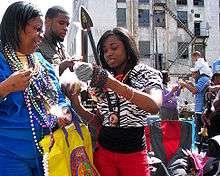
New Orleans Zulu or Mardi Gras Coconut
One of the most famous and the most sought after throws, is the Zulu Coconut also known as the Golden Nugget and the Mardi Gras Coconut.[6] The coconut is mentioned as far back as 1910, where they were given in a natural "hairy" state. The coconut was thrown as a cheap alternative, especially in 1910 when the bead throws were made of glass. Before the Krewe of Zulu threw coconuts, they threw walnuts that were painted gold. This is where the name "Golden Nugget" originally came from. It is thought that Zulu switched from walnuts to coconuts in the early 1920s when a local painter, Lloyd Lucus, started to paint coconuts. Most of the coconuts have two decorations. The first is painted gold with added glitter, and the second is painted like the famous black Zulu faces. In 1988, the city forbade Zulu from throwing coconuts due to the risk of injury; they are now handed to onlookers rather than thrown. In the year 2000, a local electronics engineer, Willie Clark, introduced an upgraded version of the classic, naming them Mardi Gras Coconuts. These new coconuts were first used by the club in 2002, giving the souvenirs to royalty and city notables.
Ojen liqueur
Aguardiente de Ojén (es), or simply "ojen" ("OH-hen") as it is known in English, is a Spanish anisette traditionally consumed during the New Orleans Mardi Gras festivities.[33] In Ojén, the original Spanish town where it is produced, production stopped for years, but it started again in early 2014 by means of the distillery company Dominique Mertens Impex. S.L.[34]
Exposure and Mardi Gras
Wearing less clothing than considered decent in other contexts during Mardi Gras has been documented since 1889, when the Times-Democrat decried the "degree of immodesty exhibited by nearly all female masqueraders seen on the streets." Risqué costumes, including body painting, is fairly common. The practice of exposing female breasts in exchange for Mardi Gras beads, however, was mostly limited to tourists in the upper Bourbon Street area.[4][35] In the crowded streets of the French Quarter, generally avoided by locals on Mardi Gras Day, flashers on balconies cause crowds to form on the streets.
In the last decades of the 20th century, the rise in producing commercial videotapes catering to voyeurs helped encourage a tradition of women baring their breasts in exchange for beads and trinkets. Social scientists studying "ritual disrobement" found, at Mardi Gras 1991, 1,200 instances of body-baring in exchange for beads or other favors.[35]
Additional photographs
See also
References
- http://www.theneworleansadvocate.com/news/elections/11507257-93/comus-brings-carnival-to-glittering
- Creecy, James R. (1860). Scenes in the South, and Other Miscellaneous Pieces. Washington: T. McGill. pp. 43, 44. OCLC 3302746.
Scenes in the South, and Other Miscellaneous Pieces.
- All on a Mardi Gras Day: Episodes in the History of New Orleans Carnival by Reid Mitchell. Harvard University Press:1995. ISBN 0-674-01622-X pg 25, 26
- Sparks, R. American Sodom: New Orleans Faces Its Critics and an Uncertain Future. La Louisiane à la dérive. The École des Hautes Études en Sciences Sociales Coloquio - December 16, 2005.
- Three centuries of Mardi Gras history. From: carnaval.com. Retrieved October 19, 2007.
- Deja Krewe. The Times-Picayune. Retrieved October 19, 2007.
- The decision of the Fifth Circuit Court of Appeals appears at volume 42, page 1483 of the Federal Reporter (3rd Series), or 42 F.3d 1483 (5th Cir. 1995).
- "Tandem float ban: 'It's a real problem' says Carnival historian Laborde". WWLTV.com. Tegna Inc. Retrieved February 23, 2020.
- Masson, Rob. "Calls for new tandem float restrictions after Nyx death". Fox8Live.com. Gray Television. Retrieved February 23, 2020.
- "Tandem floats eliminated from remaining parades after Endymion accident, officials say". NOLA.com. Retrieved February 23, 2020.
- "'We were not given a warning': New Orleans mayor says federal inaction informed Mardi Gras decision ahead of covid-19 outbreak". Washington Post. March 26, 2020. Retrieved April 9, 2020.
- Blake, Aaron (March 17, 2020). "A timeline of Trump playing down the coronavirus threat". The Washington Post. Retrieved March 19, 2020.
- "COVID-19 Timeline: See how fast things have changed in Louisiana". WWL. Retrieved April 10, 2020.
- "New Orleans has some of the highest coronavirus infection rates in the U.S. -- yet it's overlooked". NOLA.com. Retrieved March 25, 2020.
- Finch, Chris. "Gov. Edwards: Mardi Gras caused many cases of coronavirus in New Orleans area". Fox8Live.com. Retrieved March 25, 2020.
- Daigle, Adam. "Coronavirus cases grew faster in Louisiana than anywhere else in the world: UL study". The Advocate. Retrieved March 25, 2020.
- "New Orleans would have canceled Mardi Gras if feds had taken coronavirus more seriously, Mayor says". WWL. Tegna, Inc. Retrieved April 9, 2020.
- "The Truth About Carnival's Colors". My New Orleans. Retrieved July 20, 2017.
- Laborde, Errol (2007). Krewe: The Early New Orleans Carnival: Comus to Zulu. Metairie, La.: Carnival Press. pp. 57–61. ISBN 978-0-9792273-0-1.
- Laborde, Peggy Scott (June 24, 2015). New Orleans Mardi Gras Moments. Pelican Publishing Company, Inc. ISBN 9781455621200.
- Rightor, Henry (1900). Standard history of New Orleans, Louisiana, giving a description of the natural advantages, natural history ... settlement, Indians, Creoles, municipal and military history, mercantile and commercial interests, banking, transportation, struggles against high water, the press, educational ... etc. Harvard University. Chicago, The Lewis Publishing Company.
- Strachan, Sue (January 8, 2016). "Twelfth Night Revelers kicks off 2016 Carnival at ball". The Times-Picayune. Retrieved January 5, 2018.
- Stromquist, Kat (January 3, 2018). "12 parties to go to on Twelfth Night in New Orleans". Gambit. Retrieved January 5, 2018.
- "Krewe of Morpheus". www.kreweofmorpheus.com.
- "Mardi Gras Dates - Mardi Gras New Orleans". www.mardigrasneworleans.com.
- David Redmon (2008). Mardi Gras: Made in China. Culture Unplugged. Retrieved February 16, 2010.
- Redmon, David (July 8, 2014). Beads, Bodies, and Trash: Public Sex, Global Labor, and the Disposability of Mardi Gras. London: Routledge. ISBN 978-0-415-52540-4.
- Copeland, CS (January–February 2014). "It's Not All Bon Temps: Mardi Gras Can Prove Hazardous" (PDF). Healthcare Journal of New Orleans: 26–30.
- Patterson, Alice (January 24, 2020). "Creating An Amazing Mardi Gras Event". Oddle Entertainment Agency. Retrieved January 25, 2020.
- Mardi Gras History. From: mardigrasneworleans.com. Retrieved October 19, 2007.
- "Krewe". American Heritage Dictionary. Retrieved June 18, 2012.
- "Rex King of Carnival". Rex Organization. Archived from the original on October 26, 2012. Retrieved June 18, 2012.
- "New Orleans Nostalgia, "Banana Republics and Ojen Cocktails", Ned Hémard, 2007" (PDF).
- Dominique Mertens Impex. S.L., Ojén, aguardiente superior, official website, in Spanish
- Shrum, W. and J. Kilburn. "Ritual Disrobement at Mardi Gras: Ceremonial Exchange and Moral Order". Social Forces, Vol. 75, No. 2. (Dec. 1996), pp. 423-458.
External links
| Wikimedia Commons has media related to New Orleans Mardi Gras. |
| Wikivoyage has a travel guide for New Orleans Mardi Gras. |
- Carnival New Orleans History of Mardi Gras with vintage and modern pictures
- Mardi Gras Unmasked Definitive Mardi Gras and king cake histories
- MardiGras.com Web site affiliated with New Orleans' Times-Picayune newspaper
- Mardi Gras 2014 celebration photos

